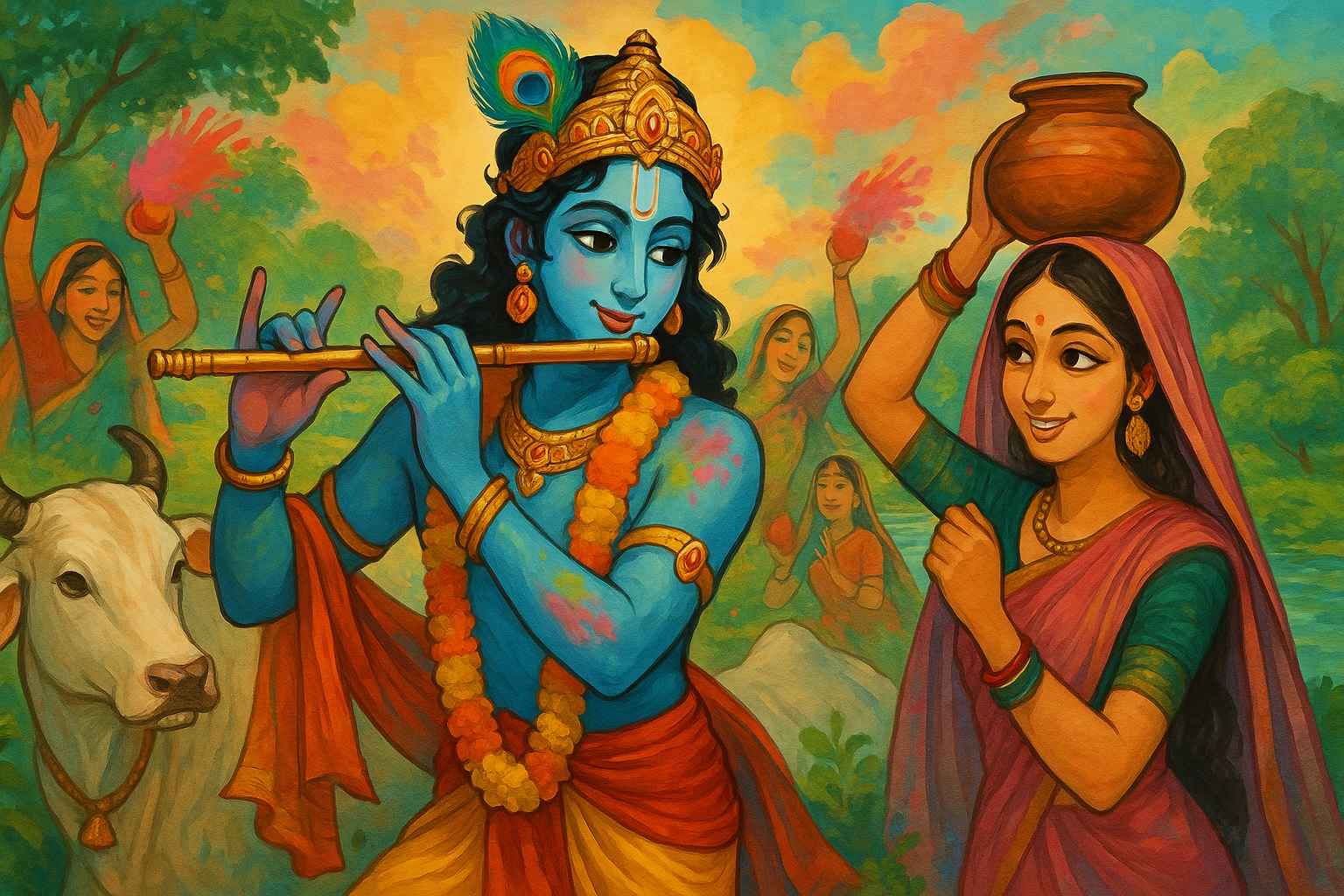“Manigar Morlivalo Shyam” paints a vibrant picture of Lord Krishna (referred to by various names like Shyam, Kanudo, Nand no Lalo) focusing on his irresistible charm, playful nature (Leela), and divine attributes.
Lyrics (ગુજરાતી)
માણિગર
મોરલીવાળો શ્યામ,
છબીલો
છેલછોગાળો શ્યામ,
હળવેથી આવીને રંગભર ખેલેને,
સન્મુખ આવીને કરે
નૈણનો ચાળો.
માણિગર મોરલીવાળો શ્યામ…
કામણગારો પેલો, કાનુડો કાળો પેલો,
જમુનાને
તીરે મારી
વાટ્યું જુએ શ્યામ
ઝટથી આવી મારી
ગાગરિયું ફોડીને,
મારુ તનમન ભીંજવી દોડી જાતો, પેલો
નંદનો
લાલો
માણિગર મોરલીવાળો શ્યામ…
જશોદાનો
જાયો, રાધાજીનો વ્હાલો,
નંદજીનો લાલો પેલો ગાયોનો
ગોવાળ
ગામને જગાડવાને
નટખટ
રંગીલાએ,
વાંસળીનો સૂર
રેલાવ્યો, આનંદ છવાયો
માણિગર મોરલીવાળો શ્યામ…
- Unknown
Explanation / Context
The song describes Krishna as the ‘Manigar’ (possessor of a gem, precious one) and ‘Morlivalo’ (flute player), highlighting his enchanting presence. It recounts his playful interactions, often associated with the Gopis or Radha by the banks of the Yamuna river – playing with colors, making flirtatious eye gestures, teasing by breaking water pots, and ultimately captivating everyone’s heart and soul. His role as the cowherd, son of Yashoda and Nanda, and beloved of Radha are all touched upon, grounding his divine playfulness in familiar narratives. The final stanza often depicts him awakening the world with the divine melody of his flute, spreading joy and bliss.
My Interpretation
This song is a pure celebration of Krishna’s magnetic personality as perceived through the eyes of a devotee. The repeated epithets – “Manigar,” “Chhabilo,” “Chhelchhogalo,” “Kamangaro” – emphasize the sheer captivating power and beauty of the divine, even in its mischievous forms. It’s not just about physical handsomeness but an enchanting aura that draws one in.
The actions described – playing Holi (rangbhar khele), breaking pots, playing the flute – are classic examples of Krishna’s Leela. They represent the divine interacting with the world in relatable, sometimes disruptive, yet ultimately enchanting ways. Breaking the pot isn’t just mischief; it can symbolize breaking the ego or worldly attachments to reach the divine love within. The flute’s melody is the divine call that awakens the soul from slumber.
Listening to or singing this Bhajan often evokes feelings of joy, affection, and a sweet longing (Bhakti) for this playful, charming aspect of the divine. It reminds us that spirituality isn’t always solemn; it can be filled with color, music, and ecstatic playfulness.
Literal Interpretation / Translation
The charming/precious flute-player Shyam (Krishna),
The handsome, stylish/flirtatious Shyam,
Gently he comes and plays full of color,
Coming face-to-face, he makes playful eye gestures
(Refrain) The charming/precious flute-player Shyam…
That magical one, that young dark Krishna,
On the banks of the Yamuna, Shyam awaits me
Quickly coming and breaking my water pots,
Drenching my body and mind, runs away, that beloved son of Nanda
(Refrain) The charming/precious flute-player Shyam…
Born of Yashoda, beloved of Radhaji,
Nanda's beloved son, that cowherd of the cows
To awaken the village, the mischievous, playful one,
Spread the melody of the flute, bliss pervaded
(Refrain) The charming/precious flute-player Shyam…
Recordings
Sachin Limaye - Manigar Murlivado
- probably the oldest version of this work
